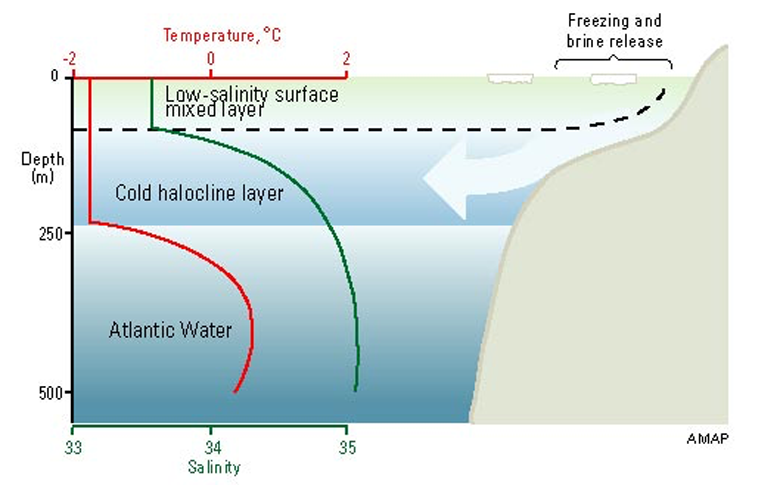Atlantification - What Warmer, Saltier Water Means For The Arctic Ocean
EDIT
There is growing evidence, too, to suggest that the unique structure of the Arctic Ocean could be shifting in this region. Scientists have uncovered “hotspots” where some parts of the Barents Sea are starting to more closely resemble the Atlantic. They call this phenomenon “Atlantification”. The extent of Atlantification across the Eurasian Arctic Basin and its possible impact on the wildlife that follow ocean currents are active areas of research. Though the overall scale and impact of Atlantification is still unclear, it could be pushing parts of Arctic towards a climate “tipping point”, Arctic scientists tell Carbon Brief.

Unlike the Atlantic and Pacific, the upper waters of the Eurasian Arctic Ocean get warmer as they get deeper. The top of the ocean is typically covered by sea ice. Below this is a layer of cool freshwater, followed by a deeper layer of warmer, saltier water delivered to the Arctic from the Atlantic by ocean currents. The layers are held in place as a result of differences in water salinity. The cool freshwater is less salty than the warmer Atlantic water and so is more buoyant. Therefore, warmer, saltier water sinks below the fresher top layer. In between, a steep salinity gradient forms. This is known as a “halocline”. The diagram below illustrates the Arctic’s unique ocean structure. On the diagram, the red line illustrates increasing water temperature with depth, while the green line illustrates increasing salinity.

An illustration of the structure of the Arctic Ocean. The red line illustrates increasing water temperature with depth, while the green line illustrates increasing salinity. Source: Arctic Monitoring and Assessment Programme (AMAP)
EDIT
This disappearance of sea ice could be sparking a shift in the structure of the ocean beneath, research suggests. One possible reason for this is that, when sea ice melts through the summer, it replenishes the freshwater layer that sits above the warmer Atlantic layer. With less sea ice around, the amount of freshwater dwindles, causing the definition between the ocean layers to weaken. This, in turn, causes the ocean to mix together, drawing more Atlantic heat up towards the surface. This “Atlantification” can, in turn, cause more ice to melt from below, says Tsamados: “By removing the ice, you are essentially taking off the blanket from on top of the Arctic Ocean and causing it to wake up. This turns the ocean from very calm to something more dynamic.”
Another way that the disappearance of sea ice can disrupt the Arctic’s structure is by leaving it vulnerable to surface winds, he says. These winds can churn up the ocean – again allowing Atlantic heat to be drawn up towards the ocean surface.
EDIT
https://www.carbonbrief.org/explainer-how-atlantification-is-making-the-arctic-ocean-saltier-and-warmer

